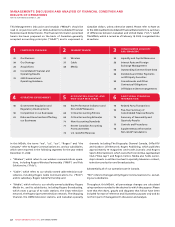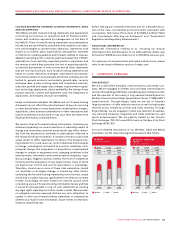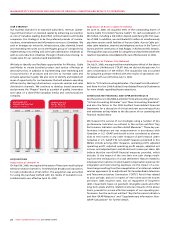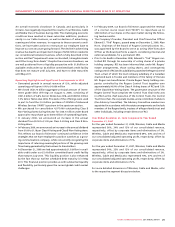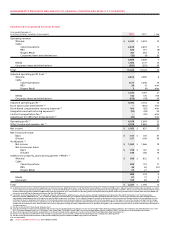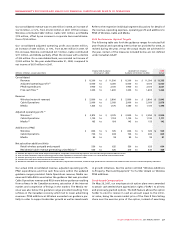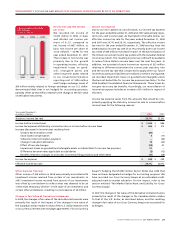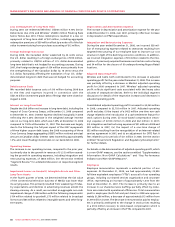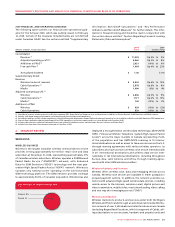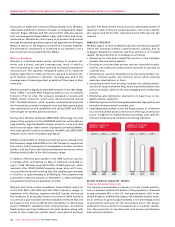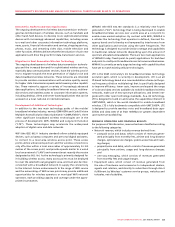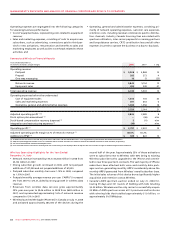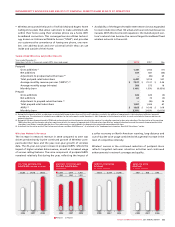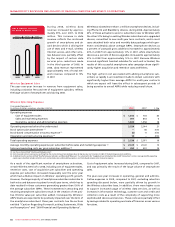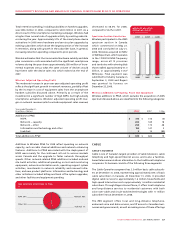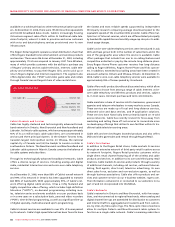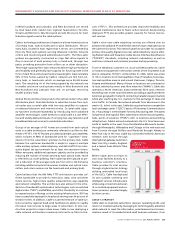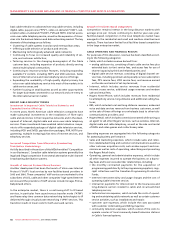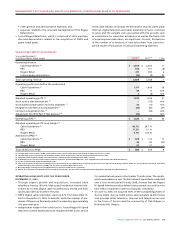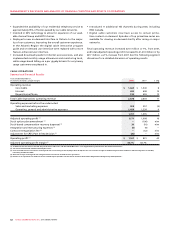Rogers 2008 Annual Report Download - page 36
Download and view the complete annual report
Please find page 36 of the 2008 Rogers annual report below. You can navigate through the pages in the report by either clicking on the pages listed below, or by using the keyword search tool below to find specific information within the annual report.
32 ROGERS COMMUNICATIONS INC. 2008 ANNUAL REPORT
MANAGEMENT’S DISCUSSION AND ANALYSIS OF FINANCIAL CONDITION AND RESULTS OF OPERATIONS
thousands of additional locations selling prepaid cards. Wireless’
nationwide distribution network includes: an independent dealer
network; Rogers Wireless and Fido stores which, effective January
2007, are managed by Rogers Retail; major retail chains; and conve-
nience stores. Wireless also offers many of its products and services
through telemarketing and through a retail agreement with Rogers
Retail, as well as on the Rogers.com and Fido e-business websites.
The information contained in or connected to our websites is not a
part of and not incorporated into this MD&A.
Wireless Networks
Wireless is a facilities-based carrier operating its wireless net-
works over a broad, national coverage area, much of which is
interconnected by its own fibre-optic and microwave transmission
infrastructure. The seamless, integrated nature of its networks
enables subscribers to make and receive calls and to activate net-
work features anywhere in Wireless’ coverage area and in the
coverage area of roaming partners as easily as if they were in their
home area.
Wireless operates a digital wireless GSM network in the 1900 mega-
hertz (“MHz”) and 850 MHz frequency bands across its national
footprint. Prior to 2002, the company operated on analog and
TDMA cellular networks, which were decommissioned during
2007. The GSM network, which operates seamlessly between the
two frequencies, provides integrated voice and high-speed packet
data transmission service capabilities and utilizes GPRS and EDGE
technologies for wireless data transmission.
During 2007, Wireless deployed UMTS/HSPA technology, the next
phase of the evolution of the GSM/EDGE platform, which delivers
high mobility, high bandwidth wireless access for voice and data
services across major urban centres. Deployed in primarily 850MHz,
with some specific locations operating in 1900MHz, the UMTS/HSPA
network covers 75.6% of Canada’s population.
Wireless holds 25 MHz of contiguous spectrum across Canada in the
850 frequency range and 60 MHz in the 1900 frequency range across
the country, with the exception of southwestern Ontario, northern
Québec, and the Yukon, Northwest and Nunavut territories, where
Wireless holds 50 MHz in the 1900 frequency range.
In addition, Wireless participated in the AWS spectrum auction
in Canada which commenced on May 27, 2008 and concluded on
July 21, 2008. Wireless acquired 20 MHz of AWS spectrum, which
operates in the 1700/2100 MHz frequency range, across all 13 prov-
inces and territories with winning bids that totalled approximately
$1.0 billion, or approximately $1.67/MHz/pop. Final payment was
submitted to Industry Canada on September 3, 2008 and Rogers
was granted its licences on December 22, 2008.
Wireless also holds certain broadband fixed wireless spectrum
in the 2300 MHz, 2500 MHz and 3500 MHz frequency ranges. In
September 2005, Wireless, together with Bell Canada, announced
the formation of an equally-owned joint venture called Inukshuk
to construct a pan-Canadian wireless broadband network that will
be based on the evolving World Interoperability for Microwave
Access (“WiMAX”) standards. Both companies have contributed
fixed wireless spectrum holdings to the joint venture, along with
access to their respective cellular towers and network backhaul
facilities. The fixed wireless network acts as a wholesale provider of
capacity to each of the joint venture partners, who in turn market,
sell, support and bill for their respective service offerings over the
network.
WIRELESS STRATEGY
Wireless’ goal is to drive profitable subscriber and revenue growth
within the Canadian wireless communications industry, and its
strategy is designed to maximize cash flow and return on invested
capital. The key elements of its strategy are as follows:
•Enhancingitsscale andcompetitivepositionintheCanadian
wireless communications market;
• Focusingonvoiceanddataservicesthatareattractivetoyouth,
families, and small and medium-sized businesses to optimize its
customer mix;
• Deliveringoncustomerexpectationsbyimprovinghandsetreli-
ability, network quality and customer service while reducing
subscriber deactivations, or churn;
• Increasingrevenuefromexistingcustomersbyutilizinganalyti-
cal tools to target customers likely to purchase enhanced services
such as voicemail, caller line ID, text messaging and wireless data
services;
• Enhancingsalesdistributionchannelstoincreasefocusontar-
geted customer segments;
• Maintainingthemosttechnologicallyadvanced,highqualityand
pervasive wireless network possible; and
• LeveragingrelationshipsacrosstheRogersgroupofcompanies
to provide bundled product and service offerings at attractive
prices, in addition to implementing cross-selling, joint sales dis-
tribution initiatives and infrastructure sharing initiatives.
RECENT WIRELESS INDUSTRY TRENDS
Focus on Customer Retention
The wireless communications industry’s current market penetra-
tion in Canada is estimated to be 66% of the population, compared
to approximately 89% in the U.S. and approximately 125% in the
United Kingdom, and Wireless expects the Canadian wireless indus-
try to continue to grow by approximately 4 to 5 percentage points
of penetration each year for the next several years. This deeper
penetration drives a need for increased focus on customer satisfac-
tion, the promotion of new data and voice services and features
and customer retention.
20082007
$75.27$72.21$67.27
200
7
2008
WIRELESS POSTPAID
MONTHLY ARPU
($)
2006
20082007
1.10%1.15%1.32%
WIRELESS POSTPAID
MONTHLY CHURN
(%)
200
7
2008
2006


